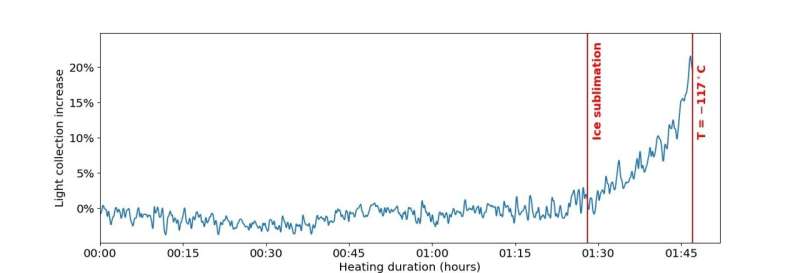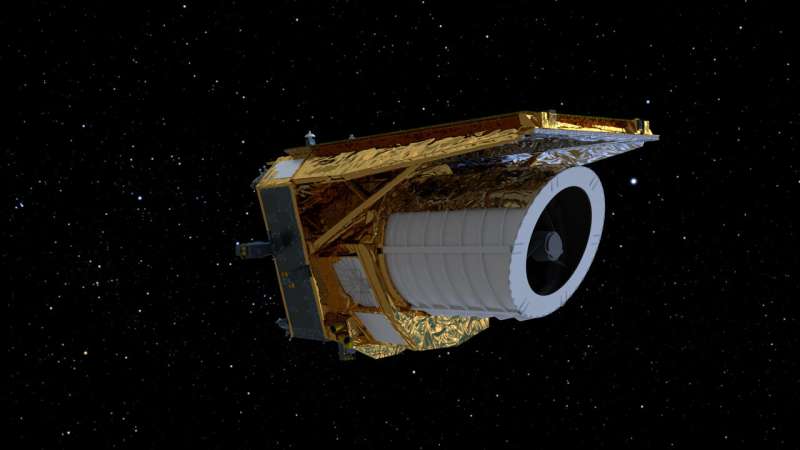A newly devised procedure to de-ice Euclid's optics has performed significantly better than hoped. Light coming in to the visible "VIS" instrument from distant stars was gradually decreasing due small amounts of water ice building up on its optics. Mission teams spent months devising a procedure to heat up individual mirrors in the instrument's complex optical system, without interfering with the finely tuned mission's calibration or potentially causing further contamination. After the very first mirror was warmed by just 34°, Euclid's sight was restored.
A little ice goes a long way
Euclid is on a mission to uncover the secrets of dark matter and dark energy, which are thought to make up 95% of the universe yet cannot be directly observed. But a few nanometers of ice—the width of a large molecule—have been accumulating on the mission's optics each month, causing a drop in the light coming in from distant galaxies.
ESA teams across Europe, at the agency's ESTEC technical heart in the Netherlands, ESOC mission control in Germany and ESAC science operations center in Spain, worked closely with the Euclid Consortium and industrial partners Thales Alenia Space and Airbus Space to investigate, research and come up with a potential solution.
"It was an enormous team effort over the last months to plan, execute and analyze the heating of selected mirrors onboard Euclid, resulting in the fantastic result we see now," explains Ralf Kohley, Euclid instrument scientist and in charge of the anomaly review board.
"The mirrors, and the amount of light coming in through VIS will continue being monitored, and the results from this first test will continue to be analyzed as we turn this experiment into a core part of flying and operating Euclid."
One by one, then group by group, they planned to heat up mirrors in Euclid's optics and test the effect on the light coming in. They had reason to believe, but couldn't know for sure, that the first mirror they would heat was causing most of the problems.

Dark universe detective sees more of the light
"It was midnight at ESOC mission control when we de-iced the first two mirrors in the procedure. We were very careful with our timings, ensuring we had constant contact between the spacecraft and our ground station in Malargüe, Argentina, so we could be ready to react in real time if there were any anomalies," explains Micha Schmidt, Euclid Spacecraft Operations Manager.
"Thankfully, it all went as planned. When we saw the first analysis provided by the science experts, we knew that they would be very happy—the result was significantly better than expected."
Mischa Schirmer, calibration scientist for the Euclid Consortium and one of the main designers of the de-icing plan, explains the results.
"Our primary suspect, the coldest mirror behind the main telescope optics, was heated from –147°C to –113°C. It didn't need to get hot, because in a vacuum this temperature is enough to quickly evaporate all the ice. And it worked like a charm! Almost immediately, we were receiving 15% more light from the universe. I was certain that we would see a considerable improvement, but not in such a spectacular way."
With Euclid's vision cleared at the very first stage of the procedure, scientists and engineers could tell where precisely the ice had formed, and where it is likely to form again. "Euclid's 'eye' has been cleared, allowing it to clearly see faint light from distant galaxies, and more of them than would otherwise be possible without this operation," explains Reiko Nakajima, VIS instrument scientist.
"We expect ice to cloud the VIS instrument's vision again in the future. But it will be simple to repeat this selective decontamination procedure every six to 12 months and with very little cost to science observations or the rest of the mission."
After months of research from scientists and engineers across Europe, late nights at ESA's ESOC mission control and 100 minutes of targeted warmth, Euclid's vision has been protected. These studies, and incredible result, will also help future satellites likely to face the same, common icy problem.
Provided by European Space Agency



